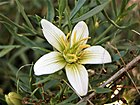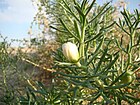Note: This is a project under development. The articles on this wiki are just being initiated and broadly incomplete. You can Help creating new pages.
Difference between revisions of "Peganum harmala"
| (One intermediate revision by one other user not shown) | |||
| Line 1: | Line 1: | ||
| − | + | [[File:Peganum harmala in Yerevan (3).jpg|thumb|right|'''Peganum harmala''']] | |
| + | '''Peganum harmala''' is commonly called wild rue, Syrian rue, African rue. It is a perennial, herbaceous plant, with a woody underground root-stock, of the family Nitrariaceae. Usually growing in saline soils in temperate desert and Mediterranean regions. | ||
==Uses== | ==Uses== | ||
| − | {{Uses| | + | {{Uses|Analgesic}}. |
==Parts Used== | ==Parts Used== | ||
| − | {{Parts Used| | + | {{Parts Used|Fruits}}. |
==Chemical Composition== | ==Chemical Composition== | ||
| − | <ref name="chemical composition"/> | + | Peganum harmala L. smoke has been used traditionally in Middle Eastern and Asian countries as a disinfectant and air purifier.<ref name="chemical composition"/> |
==Common names== | ==Common names== | ||
| − | {{Common names | + | {{Common names|kn=|ml=|sa=|ta=|te=|hi=|en=Wild rue, Syrian rue}} |
==Properties== | ==Properties== | ||
Reference: Dravya - Substance, Rasa - Taste, Guna - Qualities, Veerya - Potency, Vipaka - Post-digesion effect, Karma - Pharmacological activity, Prabhava - Therepeutics. | Reference: Dravya - Substance, Rasa - Taste, Guna - Qualities, Veerya - Potency, Vipaka - Post-digesion effect, Karma - Pharmacological activity, Prabhava - Therepeutics. | ||
===Dravya=== | ===Dravya=== | ||
| + | |||
===Rasa=== | ===Rasa=== | ||
| − | |||
===Guna=== | ===Guna=== | ||
| Line 29: | Line 30: | ||
==Habit== | ==Habit== | ||
| − | {{Habit|}} | + | {{Habit|Herbs}} |
==Identification== | ==Identification== | ||
===Leaf=== | ===Leaf=== | ||
| − | {{Leaf|||}}<ref name="Leaf"/> | + | {{Leaf|Simple|Lobes have smooth margins|1.5–2.5 mm (0.06–0.10 in) long stipules at the base. The leaf blade is dissected/forked twice or more into three to five thin, linear to lanceolate-linear, greyish lobes.}}<ref name="Leaf"/> |
===Flower=== | ===Flower=== | ||
| − | {{Flower||||}} | + | {{Flower|Bisexual||Yellowish white, White||About 2–3 cm in diameter. Greenish veins are visible in the petals. They have a threadlike, 1.2 cm long pedicel.}} |
===Fruit=== | ===Fruit=== | ||
| − | {{Fruit|||| | + | {{Fruit|Simple Fruit|Round|6–10(−15) mm in diameter|Light brown|}} |
===Other features=== | ===Other features=== | ||
| Line 46: | Line 47: | ||
==Where to get the saplings== | ==Where to get the saplings== | ||
| − | |||
==Mode of Propagation== | ==Mode of Propagation== | ||
| − | {{Propagation|}} | + | {{Propagation|Seeds}}. |
==How to plant/cultivate== | ==How to plant/cultivate== | ||
| − | <ref name="How to plant/cultivate"/> | + | Prefers a light well-drained but moisture retentive soil and an open position in full sun. Prefers a dry soil and succeeds in poor soils.<ref name="How to plant/cultivate"/> |
==Commonly seen growing in areas== | ==Commonly seen growing in areas== | ||
| − | {{Commonly seen| | + | {{Commonly seen|Tropical region}}. |
==Photo Gallery== | ==Photo Gallery== | ||
<gallery class="left" caption="" widths="140px" heights="140px"> | <gallery class="left" caption="" widths="140px" heights="140px"> | ||
| − | + | File:Peganum harmala in Yerevan (3).jpg | |
| + | File:Peganum-harmala-fruit (cropped).jpg | ||
| + | File:Peganum harmala Baikonur 07.jpg | ||
</gallery> | </gallery> | ||
==References== | ==References== | ||
| + | |||
<references> | <references> | ||
| + | <ref name="chemical composition">[https://www.tandfonline.com/doi/abs/10.1080/0972060X.2013.813241#:~:text=Peganum%20harmala%20L.,and%20volatile%20oil%20were%20analyzed. Chemical composition]</ref> | ||
| − | <ref name=" | + | <ref name="Leaf">[https://en.wikipedia.org/wiki/Peganum_harmala Morphology]</ref> |
| − | |||
| − | |||
| − | <ref name="How to plant/cultivate">[ | + | <ref name="How to plant/cultivate">[https://auntiedogmasgardenspot.wordpress.com/2013/06/25/syrian-rue-peganum-harmala-plant-care-guide/#:~:text=Cultivation%20details,very%20well%20drained%5B238%5D. Cultivation Details]</ref> |
| − | |||
</references> | </references> | ||
==External Links== | ==External Links== | ||
| − | * [ ] | + | * [https://en.wikipedia.org/wiki/Peganum_harmala Peganum harmala on wikipedia.org] |
| − | + | ||
| − | + | ||
[[Category:Herbs]] | [[Category:Herbs]] | ||
| − | [[Category: | + | [[Category:Nitrariaceae]] |
Latest revision as of 16:13, 29 June 2020
Peganum harmala is commonly called wild rue, Syrian rue, African rue. It is a perennial, herbaceous plant, with a woody underground root-stock, of the family Nitrariaceae. Usually growing in saline soils in temperate desert and Mediterranean regions.
Contents
- 1 Uses
- 2 Parts Used
- 3 Chemical Composition
- 4 Common names
- 5 Properties
- 6 Habit
- 7 Identification
- 8 List of Ayurvedic medicine in which the herb is used
- 9 Where to get the saplings
- 10 Mode of Propagation
- 11 How to plant/cultivate
- 12 Commonly seen growing in areas
- 13 Photo Gallery
- 14 References
- 15 External Links
Uses
Parts Used
Chemical Composition
Peganum harmala L. smoke has been used traditionally in Middle Eastern and Asian countries as a disinfectant and air purifier.[1]
Common names
| Language | Common name |
|---|---|
| Kannada | |
| Hindi | |
| Malayalam | |
| Tamil | |
| Telugu | |
| Marathi | NA |
| Gujarathi | NA |
| Punjabi | NA |
| Kashmiri | NA |
| Sanskrit | |
| English | Wild rue, Syrian rue |
Properties
Reference: Dravya - Substance, Rasa - Taste, Guna - Qualities, Veerya - Potency, Vipaka - Post-digesion effect, Karma - Pharmacological activity, Prabhava - Therepeutics.
Dravya
Rasa
Guna
Veerya
Vipaka
Karma
Prabhava
Habit
Identification
Leaf
| Kind | Shape | Feature |
|---|---|---|
| Simple | Lobes have smooth margins | 1.5–2.5 mm (0.06–0.10 in) long stipules at the base. The leaf blade is dissected/forked twice or more into three to five thin, linear to lanceolate-linear, greyish lobes. |
Flower
| Type | Size | Color and composition | Stamen | More information |
|---|---|---|---|---|
| Bisexual | Yellowish white, White | About 2–3 cm in diameter. Greenish veins are visible in the petals. They have a threadlike, 1.2 cm long pedicel. |
Fruit
| Type | Size | Mass | Appearance | Seeds | More information |
|---|---|---|---|---|---|
| Simple Fruit | Round | 6–10(−15) mm in diameter | Light brown | {{{6}}} |
Other features
List of Ayurvedic medicine in which the herb is used
Where to get the saplings
Mode of Propagation
How to plant/cultivate
Prefers a light well-drained but moisture retentive soil and an open position in full sun. Prefers a dry soil and succeeds in poor soils.[3]



